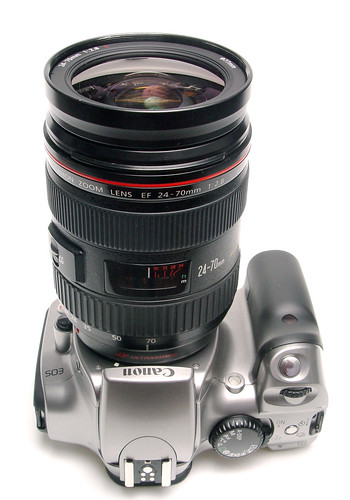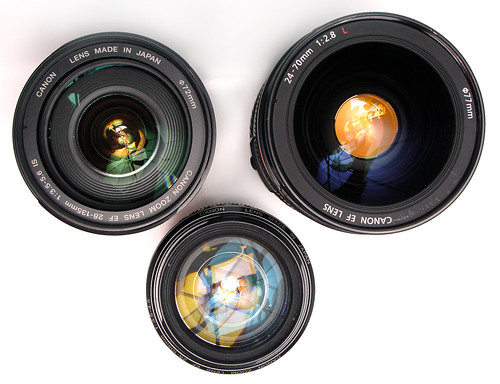Canon 300D (Digital Rebel) [2003]Pictures Taken By The Other Martin Taylor With This Camera There's no point in me writing an amateur review of the original Digital Rebel for two reasons:
The 300D was my main camera for more than two years, so, instead, I offer my user experiences. The Buying Decision
Why would I do such a thing when there are so many other, more exciting, better featured and sexy cameras available? In the end, as it so often is, it was largely a matter of price. My hand was forced. I wasn't entirely sure that I was ready to buy into a DSLR system but my main digicam, my much loved Sony F717, started to fail me. Luckily my extended warranty still covered the F717 when it failed to acknowledge the presence of memory sticks but I took it as a sign that it was time to move on. Still, I wanted this upgrade to be painless as possible both financially and emotionally. For $825 from Adorama I got the 300d kit (including the much criticized 18-55mm standard zoom), a 5 year extended warranty, a 1 gb memory card and a Canon 50mm f1.8 standard lens all shipped from NY to SF. That was a pretty amazing deal at the time especially when you consider that 2 and a half years previous to that my F717 alone cost considerably more. Why didn't I just spend the extra three hundred bucks to get the new and improved Rebel 350xt? When I searched my motives I knew that I didn't want the 350XT over the 300D because of the extra 2 megapixels or the faster startup times or larger buffer; I wanted the 350XT because it came in professional black rather than amateur silver. I couldn't justify the extra expense just to satisfy my vanity as it goes against my photographic principles. I'm not a professional. I am an amateur and I am supposed to embrace that. The 300D was more than enough camera to get me going and, if I turned out to love the Canon system, I could get the 20D's equivalent in a couple of years having lost little and having paid my initial, DSLR dues at a very reasonable, financial investment. Lenses
Of course, that all changes with the move to a DSLR. Contemplating lens choices is a little intimidating and pretty geeky. Not that I'm unfamiliar with the process but my knowledge ended with late-80's technology. When I was assembling my Olympus (OM) system primes were more desirable among photogs; zooms were for uneducated consumers. Things have changed; zooms are used by professionals and are available in all sorts of configurations beyond the old 35-70mm and 70-210mm 1980's norms. I have a lot to learn and, as usual, I'm trying to get the best value for my pennies that I can. The first choice is easy; the standard 18-55mm kit lens that comes with the digital rebel. I couldn't have got the rebel body alone any cheaper than I got the kit so the standard lens was basically free. For free the 18-55mm is better than you would think and with a 27-88mm equivalence in the 35mm world it makes a pretty good walkabout and wide angle lens. When I ordered the Rebel I also ordered the standard Canon 50mm f1.8 lens. For $70 you get a fast 80mm equivalent lens that is very sharp and makes for a great low light and portrait lens. It's not a very well kept secret but the little Canon 50mm f1.8 is probably the best lens bargain out there, period. But I wanted a little more reach and quality from my walkabout zoom lens. The Canon EF 28-105 f3.5-4.5 II USM looked like it would fit the bill. It is reasonably priced at $250 retail but it's a even more solid bargain when you pick one up from the local classifieds, mint for $140. It has a very usable focal length with a 35mm equivalence of 45-169mm. It's reasonably fast and well reviewed. Focusing is much faster and more positive than the kit lens. It is also much more solidly built with a metal mount, focusing scale and full time manual focus available (you can just grab the focusing ring and adjust without even switch the lens to MF). It's quite a bit heavier than the kit lens but it is still not bulky to carry. Currently it is my favorite lens. A few months later I got my 'zoo lens'; the Canon 75-300 f4-5.6 IS. The image stabilized version was a tad over $400. In 35mm terms it's a 120-480mm zoom and the stabilization really works and is very useful at these longer focal lengths. This lens is much criticized by 'L' snobs; granted, it may be a little soft at the long end and it is slow to focus but don't write this lens off without trying it first. If you play to its strengths it's a very usable lens. For moment I have lenses covering all the focal lengths I want (28-480mm). None are particularly exotic or high-end but I do have a very usable kit for very reasonable money. User ConclusionLet's get the criticism out of the way:
What have been the biggest advantages to me moving to a DSLR?
User Update [2007]By Christmas of 2006 the 300D was feeling a little slow and old. Although I previously stated that the speed issue was not a problem as time went on I got increasingly frustrated by missing shots while the camera woke up and while it cleared its buffer. When the 400D xti was released, it was a no brainer. For a short time my wife used the 300D as she transitioned from a digicam to a DSLR but she hated the buffer limitation especially when she compared it to my new Rebel. When I got tired of her stealing my 400D, I caved and bought another copy of the 400D. The 300D still produces great images and is still very reliable. These days it is in semi-retirement, however. I still take it out when I am going somewhere that I think my equipment may be at risk and it gets loaned out to friends and visitors when they need it or when they want to join us on a photo-stroll. I still also use the 300D when I want two different lenses available at the same time and my wifes camera isn't available. These days I see 300D's on CraigsList for $400 or less. If you have the money I'd definitely plumb for the new Rebel but if you're on a tight budget and you just don't want to wait to jump on the DSLR bandwagon then picking up one of these secondhand cast-offs is a valid and viable option. A 6 megapixel RAW file from the 300D will still surpass a 10 megapixel JPG from today's most advance point and shoot IMO. Pictures Taken By The Other Martin Taylor With This Camera |
|
All content © 2003-2011 the other Martin Taylor.
 In 2003 there was only one choice for the
enthusiast
photographer wanting to step-up from a digicam to
a DSLR and that
was Canon's 300D (the original Digital Rebel). By 2005 the enthusiast
had a boat-load more options including the new Rebel (350xt), the
Pentax
*ist, the Nikon D70 (and the new D70s & D50), the Olympus
eVolt, the Canon
D20 and many more. Being an Olympus fan-boy I really wanted to like the
eVolt
but two things stopped me from remaining loyal to the Olympus brand;
its
smaller sensor means more noise than its more mainstream competitors,
and
the lack of reasonable priced lens options. After much internal debate
I made
the safe, boring and unspectacular choice of getting the original rebel
(300D).
In 2003 there was only one choice for the
enthusiast
photographer wanting to step-up from a digicam to
a DSLR and that
was Canon's 300D (the original Digital Rebel). By 2005 the enthusiast
had a boat-load more options including the new Rebel (350xt), the
Pentax
*ist, the Nikon D70 (and the new D70s & D50), the Olympus
eVolt, the Canon
D20 and many more. Being an Olympus fan-boy I really wanted to like the
eVolt
but two things stopped me from remaining loyal to the Olympus brand;
its
smaller sensor means more noise than its more mainstream competitors,
and
the lack of reasonable priced lens options. After much internal debate
I made
the safe, boring and unspectacular choice of getting the original rebel
(300D). One of the 'advantages' of using a pro-sumer
digicam is its fixed (i.e. non-removable)
lens. That could be one of the reasons I stuck with the F717 so long.
Apart
from my supplemental wide-angle (a very large and cumbersome Olympus
0.7x converter
- the B28) there were no other lens choices to worry about. There was
little
reason to lust after additional lenses. There was nothing I could do
with the
lens that came with the camera except work with it. When I left for a
shoot
I didn't have to worry about what lenses I needed to take with me.
One of the 'advantages' of using a pro-sumer
digicam is its fixed (i.e. non-removable)
lens. That could be one of the reasons I stuck with the F717 so long.
Apart
from my supplemental wide-angle (a very large and cumbersome Olympus
0.7x converter
- the B28) there were no other lens choices to worry about. There was
little
reason to lust after additional lenses. There was nothing I could do
with the
lens that came with the camera except work with it. When I left for a
shoot
I didn't have to worry about what lenses I needed to take with me.